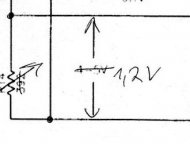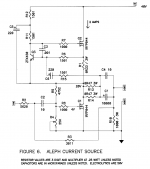Hi Zen Mod,
measured 1,9V across drain resistor input LTP and 0,5V over source resitor of SS is 1,4V, not a good value for Vgsthreshold?
that's good
 , but what puzzled me is this :
, but what puzzled me is this :Attachments
yo Papa !
😉
btw - Generg - it's almost frightening to ask you - how many pairs of SS you bought ?
being in at least semi-decent retirement in Vaterland can't be bad ..... I hope and presume
😉
btw - Generg - it's almost frightening to ask you - how many pairs of SS you bought ?
being in at least semi-decent retirement in Vaterland can't be bad ..... I hope and presume
Tomorrow I will make this.....🙂🙂🙂🙂🙂
"In any case, to achieve this 50%, you would have to adjust R15 so that
the AC current through R1 is one half the current going through the
parallel R13 and 14. In the case of the values shown, ( generg: o,33 and two 0,47 parallel in the schematic, remind me that Aleph 3 has other values!)) that means that when the amplifier is driving a load, the AC voltage across R1 is 70% of
the voltage across the combination of R13 and 14. You can use an AC
voltmeter at 60 Hz to check this figure if you need to confirm proper
operation of the circuit. Decreasing R15 increases the percentage, and
vice versa. If you want a switchable variable/constant current source,
install a switch to break the R15 circuit."
Nelson Pass in Zen Var II
Thanks Mr. Nelson!
😎😎😎😎😎😎😎😎
"In any case, to achieve this 50%, you would have to adjust R15 so that
the AC current through R1 is one half the current going through the
parallel R13 and 14. In the case of the values shown, ( generg: o,33 and two 0,47 parallel in the schematic, remind me that Aleph 3 has other values!)) that means that when the amplifier is driving a load, the AC voltage across R1 is 70% of
the voltage across the combination of R13 and 14. You can use an AC
voltmeter at 60 Hz to check this figure if you need to confirm proper
operation of the circuit. Decreasing R15 increases the percentage, and
vice versa. If you want a switchable variable/constant current source,
install a switch to break the R15 circuit."
Nelson Pass in Zen Var II
Thanks Mr. Nelson!
😎😎😎😎😎😎😎😎
Attachments
Last edited:
Generg - it's almost frightening to ask you - how many pairs of SS you bought ?
let me count....14x SR100 And 4x R500....I lost one SSR100 by accident😱
when I am ready with my amplifier I will give the rest to friends.....🙂
you have source resistors in both lower and upper half of circ ( meaning on your actual amp)
presuming that they're same in value - and if you have 2-channel CRO , and if you know where are both test-tips ( sonde .... proper Engrish words ?) - just compare AC voltages across lower and upper source resistor
- just compare AC voltages across lower and upper source resistor
presuming that they're same in value - and if you have 2-channel CRO , and if you know where are both test-tips ( sonde .... proper Engrish words ?)
 - just compare AC voltages across lower and upper source resistor
- just compare AC voltages across lower and upper source resistoryou mean :
seems that you will going to buy few more
especially if you are going to make susy shark

..... with my amplifiers ......
seems that you will going to buy few more
especially if you are going to make susy shark

...... you know I passed nearly the whole First Watt Line, thats why I wrote "amplifers". It is such a pleasure to make electronics again, than always teaching........
and I have enough SSR100 to make "susy shark", but I am afraid of heatsinking, transformers etc.
and I have enough SSR100 to make "susy shark", but I am afraid of heatsinking, transformers etc.
Hi Bill, Hi Zen Mod, 😀😀
the new news... yesterday I was very convinced I would measure the AC current delivered by the Semisouth and by the CCS like Nelson suggested.
this morning bevor I took out the soldering iron, I heard some music and because I had yesterday implemented three resistors for R21, the one that feeds back the signal to CCS, I switched only the three values 750 Ohm, 500 Ohm and 310 Ohm.
Result: less Ohm, louder sound, CCS contributes power
More result: sound got more and more darker, not unpleasant.
more more result: definition got worse
difficulty: changing the volume to get the same level between the steps
surprise:without any resistor (Nelson mentions this possibility) - best definition, most airy sound, nearly too soft, but impressive - a must hear
conclusions:
- because Nelson shows the decrease of distortion by using aleph ccs it must be the blend in of the IRF240, that takes away definition. I will not speak per se against the IRF, may be the mix does not work well or there is no way back the SemiSouth is simply better.
- would be interesting to replace the IRF by a Semi, I know it is not recommended, but i am interested to hear the blend with two SemiS
- small signal j-fets and SSouth are unbeatable for resolution, airiness and more or less analogue softness. (the same experience I made with ZMs Babelfish J2, being more precise, less soft)
next steps: I will try three models CCS for the differential pair, original A5 with IRF9610, two or three SK170 (see frontstage BA-2) and the solution of aleph J
and look for the sound and hum..
happy generg🙂🙂🙂
the new news... yesterday I was very convinced I would measure the AC current delivered by the Semisouth and by the CCS like Nelson suggested.
this morning bevor I took out the soldering iron, I heard some music and because I had yesterday implemented three resistors for R21, the one that feeds back the signal to CCS, I switched only the three values 750 Ohm, 500 Ohm and 310 Ohm.
Result: less Ohm, louder sound, CCS contributes power
More result: sound got more and more darker, not unpleasant.
more more result: definition got worse
difficulty: changing the volume to get the same level between the steps
surprise:without any resistor (Nelson mentions this possibility) - best definition, most airy sound, nearly too soft, but impressive - a must hear
conclusions:
- because Nelson shows the decrease of distortion by using aleph ccs it must be the blend in of the IRF240, that takes away definition. I will not speak per se against the IRF, may be the mix does not work well or there is no way back the SemiSouth is simply better.
- would be interesting to replace the IRF by a Semi, I know it is not recommended, but i am interested to hear the blend with two SemiS
- small signal j-fets and SSouth are unbeatable for resolution, airiness and more or less analogue softness. (the same experience I made with ZMs Babelfish J2, being more precise, less soft)
next steps: I will try three models CCS for the differential pair, original A5 with IRF9610, two or three SK170 (see frontstage BA-2) and the solution of aleph J
and look for the sound and hum..
happy generg🙂🙂🙂
Hi generg, removing the resistor turns the aleph circuitry off, making it a CCS. If you want to experiment more, increase the resistor to 1.2K or higher, that gives less AC current gain.
yes Bill, I know and I did not want to do it because I wanted by the aleph CCS the more of power I needed for my four Ohm speaker but
as described the sound without is simply better....
as described the sound without is simply better....
I understand. If your heatsinks are large enough you can increase the bias for a little more power capability.
yes I will do this!
but first the little research about aleph with two identical semiconductors...
but first the little research about aleph with two identical semiconductors...
........
- would be interesting to replace the IRF by a Semi, I know it is not recommended, but i am interested to hear the blend with two SemiS
.....
I believe that small BJT will be starving at such low E-C voltage ;
anyway - be sure to set AC gain to desired level ...... because it is in function of Aleph CCS active output device
........
.....
next steps: I will try three models CCS for the differential pair, original A5 with IRF9610, two or three SK170 (see frontstage BA-2) and the solution of aleph J
and look for the sound and hum..
.....
I know what's my fave , if nothing else than from engineering reasons
be aware that I'm not an engineer

🙂 o.k. I heard the aleph current source with two SemiS in the lower and upper half.🙂
I tried all three values again and the change in sound to the darker and less resolution is not remarkable. BTW this are only small changes, nothing to get grey hairs....😀
means, with aleph current source its better to have to similar......
and two IRF will behave well also....😀
I tried all three values again and the change in sound to the darker and less resolution is not remarkable. BTW this are only small changes, nothing to get grey hairs....😀
means, with aleph current source its better to have to similar......
and two IRF will behave well also....😀
and Zen Mod
is there any danger by the low E-C voltage for the small BJT or my amplifier, is their function not o.k. or what will happen...?
is there any danger by the low E-C voltage for the small BJT or my amplifier, is their function not o.k. or what will happen...?
Exactly, except I'm not the "ZenMod". Look at the data sheet and the saturation charactersics.
I suggest an EF xistor from Colector of the the CSS "regulator" to the Gate of the CSS FET. Then the ZTX (BC whatever) has just enought EC voltage to operate well.
Choose.
I suggest an EF xistor from Colector of the the CSS "regulator" to the Gate of the CSS FET. Then the ZTX (BC whatever) has just enought EC voltage to operate well.
Choose.

Hi flg,
should I not switch on the amplifier?😱
I did not know the expression, I found "xistor" means "transistor" but what is "EF"? three legs? four legs are good, two legs are bad....
sorry.....🙂
Exactly
should I not switch on the amplifier?😱
suggest an EF xistor
I did not know the expression, I found "xistor" means "transistor" but what is "EF"? three legs? four legs are good, two legs are bad....
sorry.....🙂
- Status
- Not open for further replies.
- Home
- Amplifiers
- Pass Labs
- My Aleph3/5-BA-2-Semisouth-J2 Clone Monster

 oh, oh, oh ..........
oh, oh, oh ..........
